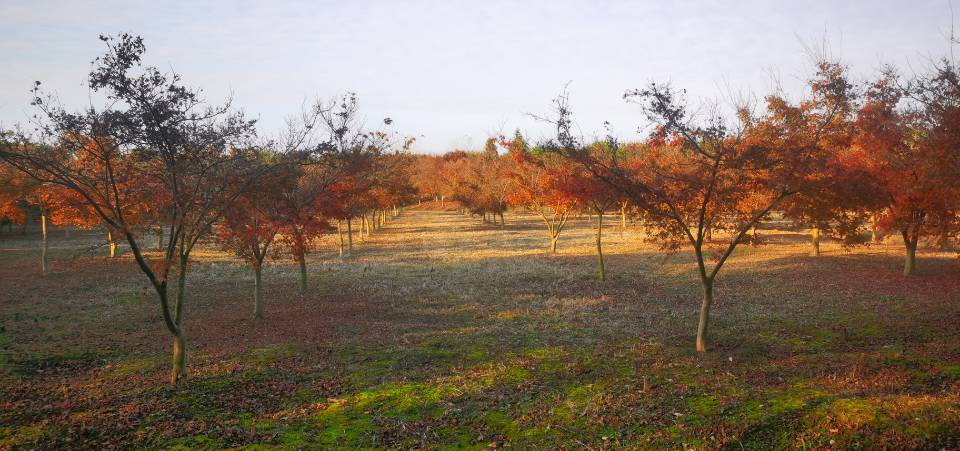 PDF(2026 KB)
PDF(2026 KB)


Morphological characteristics and wind dispersal characteristics of samara of common Acer species
WU Hong, YAN Liping, LI Chengzhong, XIA Qun, ZHOU Xia, ZHAO Baoyuan
JOURNAL OF NANJING FORESTRY UNIVERSITY ›› 2021, Vol. 45 ›› Issue (2) : 103-110.
 PDF(2026 KB)
PDF(2026 KB)
 PDF(2026 KB)
PDF(2026 KB)
Morphological characteristics and wind dispersal characteristics of samara of common Acer species
 ,
,
【Objective】In order to explore the correlation between samara characteristics and wind dispersal characteristics and provide theoretical reference for further study on the mechanism of wind dispersal and population expansion of Acer samaras, characteristics of 15 Acer species samaras were studied.【Method】The 1 000-grain-weight, seed length, seed width, wing length, wing width, angle of samara , ratio of seed length to width, ratio of seed length to wing length and the dispersal characteristics (settlement velocity and horizontal dispersal distance) of 15 Acer samara were studied by simulation experiments, and the correlation between samara characteristics and wind dispersal characteristics was compared.【Result】① The angle of samara had the greatest influence on settlement velocity and horizontal dispersal distance, while the seed width had the weakest influence. ② The samara settlement velocity ranged from 69.14 to 224.06 cm/s; the slowest was Acer flabellatum and the fastest was Acer negundo. The horizontal dispersal distance also varied, and the farthest was Acer negundo and the nearest was Acer flabellatum. ③ The samara settlement velocity was positively correlated with seed length, wing length, wing width, ratio of seed length to width, and ratio of seed length to wing length, and negatively correlated with the angle of samara and seed width. The horizontal dispersal distance was negatively correlated with the angle of samara, seed length, wing length, wing width, ratio of seed length to width, and ratio of seed length to wing length, but positively correlated with seed width. The horizontal dispersal distance was negatively correlated with the samara settlement velocity. Samara settlement velocity and horizontal dispersal distance were affected by many morphological indexes. ④ Principal component analysis of eight samara characters of 15 species of Acer showed that the cumulative contribution rate of the first three principal components was 82.911%. The genetic relationship of 15 Acer species was examined via cluster analysis of eight traits, when euclidean distance is 10, 15 Acer species can be divided into 4 groups.【Conclusion】The correlation analysis showed that the effects of samara morphological characteristics on settlement velocity were as follows: angle of samara > ratio of seed length to wing length > seed length > wing length > ratio of seed length to width > wing width > seed width. The horizontal dispersal distance of samara is restricted by many factors. The 1 000 seed mass, angle of samara, and ratio of seed length to wing length can be used as important factors for the classification of Acer.

Acer / samara characters / settlement velocity / horizontal dispersal distance / principal component analysis / cluster analysis
| [1] |
|
| [2] |
|
| [3] |
|
| [4] |
|
| [5] |
|
| [6] |
|
| [7] |
|
| [8] |
吴建国, 徐天莹. 模拟未来气候变化对东北6种蒲公英种子风传播距离的影响[J]. 生态学杂志, 2018,37(3):914-928.
|
| [9] |
|
| [10] |
戴志聪, 杜道林, 司春灿, 等. 用扫描仪及Image J软件精确测量叶片形态数量特征的方法[J]. 广西植物, 2009,29(3):342-347.
|
| [11] |
|
| [12] |
王季槐,
|
| [13] |
高振华, 张玉强, 田林土, 等. 不同造林密度杉木速生丰产林经济效益主成分分析及政策优化[J]. 南京林业大学学报, 1996,20(3):78-83.
|
| [14] |
徐廷志. 翅果形态及其在槭树科分类与演化上的意义[J]. 广西植物, 1996(2):109-122.
|
| [15] |
潘燕, 王帅, 王崇云, 等. 云南松与云南油杉种子风力传播特征比较[J]. 植物分类与资源学报, 2014,36(3):403-410.
|
| [16] |
郭强, 朱敏, 徐勒, 等. 五种杂草种子沉降速度[J]. 生态学杂志, 2008,27(4):519-523.
|
| [17] |
|
| [18] |
|
| [19] |
诸葛晓龙, 朱敏, 郭强. 线性及机理模型的种子风传扩散距离预测[J]. 中国计量学院学报, 2011,22(2):181-184.
|
| [20] |
杨允菲, 祝玲. 松嫩平原碱化草甸野大麦的种子散布格局[J]. 植物学报, 1994(8):636-644.
|
| [21] |
|
| [22] |
|
| [23] |
|
| [24] |
|
| [25] |
|
| [26] |
罗靖德, 甘小洪, 贾晓娟, 等. 濒危植物水青树种子的生物学特性[J]. 云南植物研究, 2010,32(3):204-210.
|
| [27] |
谭珂, 董书鹏, 卢涛, 等. 被子植物翅果的多样性及演化[J]. 植物生态学报, 2018,42(8):806-817.
|
/
| 〈 |
|
〉 |